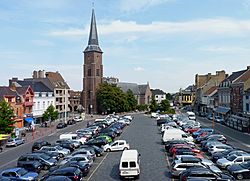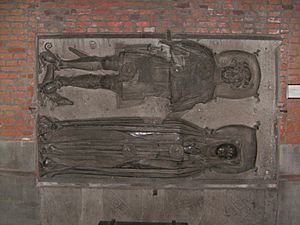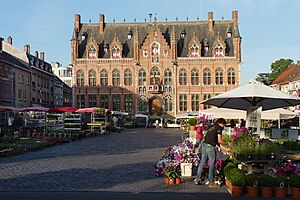Mouscron facts for kids
Quick facts for kids
Mouscron
Moucron (Picard)
Moeskroen (Dutch)
|
|||
|---|---|---|---|
 |
|||
|
|||
| Country | Belgium | ||
| Community | French Community | ||
| Region | Wallonia | ||
| Province | Hainaut | ||
| Arrondissement | Tournai-Mouscron | ||
| Population
(2018-01-01)Lua error in Module:Wd at line 1575: attempt to index field 'wikibase' (a nil value).
|
|||
| • Total | Lua error in Module:Wd at line 1,575: attempt to index field 'wikibase' (a nil value). | ||
| Postal codes |
7700, 7711, 7712
|
||
| Area codes | 056 | ||
| Website | www.mouscron.be | ||
Mouscron is a city and municipality in Wallonia, a region in Belgium. It is located in the province of Hainaut. Mouscron is right on the border with France, next to the French city of Tourcoing. This area is part of the larger Lille metropolitan area.
The municipality of Mouscron includes several smaller areas called districts. These are Dottignies, Herseaux, Luingne, and Mouscron itself. Because of a special national law, Mouscron offers services for people who speak Dutch. This helps the Dutch-speaking minority in the area. The city of Kortrijk in Flanders is just north of Mouscron.
Mouscron grew a lot in the 1800s and early 1900s. This was because the textile industry became very big in northern France. The city's special symbol is the Hurlu. This character represents Protestant activists from the 1500s. They were known for raiding the countryside during the Wars of Religion.
Contents
Geography of Mouscron
Mouscron is divided into seven main parts. These are the downtown area (le centre), the train station (la gare), Mont-à-Leux, Tuquet, Risquons-Tout, Nouveau-Monde, and Coquinie. The municipality also includes the older towns of Dottignies, Luingne, and Herseaux. These towns joined Mouscron during the merger of Belgian municipalities.
Mouscron is part of a large urban area connected to the French city of Lille. It is also where three different regions meet: Wallonia (in Belgium), France, and Flanders (in Belgium). Mouscron is close to many cities. It is 9 km from Roubaix, 11 km from Kortrijk, 23 km from Lille, and 25 km from Tournai. Since 1963, Mouscron has been part of the French-speaking province of Hainaut. This means it is also part of the Wallonia region.
History of Mouscron
Early History and Middle Ages
Archaeologists have found signs that people lived in the Mouscron area during Roman times. The village name Dottignies was first written down in the 800s. Mouscron's name appeared later, in 1060.
In 1066, a ruler named Baldwin V, Count of Flanders gave local buildings and land to the Church of Saint-Pierre in Lille. Later, in 1149, parts of Mouscron were given to the Abbey of Saint Martin in Tournai and the Tournai Cathedral. The nearby villages of Herseaux and Luingne also became part of the Tournai Cathedral's land in 1178.
By the 1300s, the land of Mouscron was sold to a lord from Tournai. In 1430, the Château des Comtes (Castle of the Counts) became the lord's main house. You can still see parts of this castle today. A famous future emperor, Charles V, Holy Roman Emperor, even stopped there for dinner on May 27, 1516.
From the 1500s to the 1700s
In 1575, during the Wars of Religion, the castle was made stronger. But in 1579, it was attacked and captured by the Geuzen, who were known locally as the Hurlus. The castle was taken back three months later.
In 1627, Philip IV of Spain made Mouscron's land into a county. The Franco-Dutch War under Louis XIV caused a lot of damage to this farming area. Mouscron and its surroundings became part of France after the Treaty of Aix-la-Chapelle (1668). Some parts of it returned to the Southern Netherlands after the Treaty of Nijmegen (1678). This treaty even drew the border right through Mouscron. Finally, in 1713, Mouscron became fully part of the Southern Netherlands under the Treaty of Utrecht.
The textile industry started in Mouscron in the 1760s. This happened because the city of Lille banned making a fabric called molletons (a mix of flax and wool) in Roubaix and Tourcoing. After the Battle of Fleurus (1794), Mouscron became part of France again.
The 1800s and 1900s
At the start of the 1800s, the textile industry grew even more. Cotton became an important material. On March 29, 1848, the Belgian army stepped in near Mouscron. They stopped a group of French people who wanted to invade Belgium. This event is known as the Risquons-Tout incident.
By the end of the 1800s, many cotton and carpet factories were built. This caused the village to grow into a much bigger city. This growth was especially strong after World War I.
During World War II, from May 22 to 27, 1940, British and German soldiers fought in the Risquons-Tout area. Sadly, 15 British soldiers, 10 German soldiers, and 5 civilians died there.
In 1963, Mouscron was moved from the province of West Flanders to the province of Hainaut. This change happened because most people in Mouscron spoke French. In 1846, 94% spoke French, and in 1947, 74% did. Mouscron was officially recognized as a city in 1986.
Places to See in Mouscron
- The Town Hall and Main Square: The town hall opened in 1890. It was designed by architect René Aimé Buyck. Its style is called neo-Gothic. People admire the building for its balanced design and detailed sculptures.
- The Saint-Barthélémy Church: This is an important local church.
- The Medieval Castle (Château des Comtes): You can still visit this old castle. The oldest parts were built in the 1400s. Four families of lords lived here for six centuries. What remains today are its courtyard, some buildings from the 1500s and 1600s, and the moats (water-filled ditches).
- Mouscron's Public Park: This park was created in the 1930s. It has ponds and well-kept green areas. It is home to many different plants that can grow in the local weather. The park covers an area of 7 hectares (about 17 acres). It opened in 1932.
- The House of Picardy (Maison Picarde): This building was built around 1922. The inside is interesting to see. The painted tiles in the main hall on the second floor are considered historical treasures. They show peaceful country scenes that celebrate ideas like hard work, learning, and family. These tiles were made by Jules Biesbroek's studio.
- The Urban Renewal (La Rénovation urbaine): In the early 1980s, a big project started to make the city center better. The old Green Square was changed and renamed Emmanuel de Neckere Square. Look closely at the paving stones; they show the city's motto: "Loyal to the King, up to carrying the beggar's pouch." In the middle of this modern area, you can see a fountain made by local artist Bernard Verhaeghe in 1987.
- The Olympic-Size Swimming Pool (Les dauphins): A large pool for swimming.
- The Cultural Center (Marius Staquet): This center has three main parts: the Raymond Devos theater, the André Demeyère auditorium, and the Jacques Brel exhibition hall.
- The Exhibition Hall (Centr’expo): This place hosts different shows, fairs, and events.
- The Art Gallery: This gallery is set up in the old swimming pool building.
- The Stadium (Cannonier): This stadium can hold 10,830 people for sports events.
- The Public Library: A place to find books and learn.
- The El Bar Café: This café hosts live music concerts.
- Studio RQC (Radio qui chifel): This is the city's independent radio station.
Fun Festivals in Mouscron
- The Hurlus Festival (Fête des Hurlus): This festival happens every first weekend of October.
- On Friday evening, children gather in the main square for a lantern parade. They walk around the city with music and traditional groups, singing a special song.
- On Saturday, people walk around downtown to see traditional groups, majorettes, musicians, and craftspeople. There is also a big bowls competition. Then, a historical parade goes through the streets. It shows two old stories: the Hurlus kidnapping a Spanish-allied priest, and a fight between the Spanish leader and the Hurlu leader. If the Hurlu leader wins the show, small Hurlu dolls are thrown into the crowd.
- The celebrations continue with drums and trumpets until Sunday. On Sunday, more Hurlu dolls are thrown from a high platform in the main square.
- The Hand Festival (Fête de la Main) in Dottignies: This festival takes place every third weekend of September. A group of Gilles (performers in special costumes) walks through the village streets. They give out oranges to people passing by. The festival is named after a copper hand that sits on top of the church steeple in Dottignies. This hand might be a symbol of friendship.
- Christmas Market: A Christmas Market is held every year on the main square.
- The Vingt-Quatre Heure de Mouscron: This event happens every September. Its main goal is to raise money for charity. Groups of athletes run around the city for 24 hours straight.
Mouscron's Musical History
From 1960 to 1980, Mouscron was a lively place for the music industry.
A studio run by Marcel De Keukeleire and Jean Van Loo helped create famous European artists. These included Chocolat's (known for "Brasilia Carnaval"), Patrick Hernandez (who sang "Born to Be Alive"), and J. J. Lionel (famous for the "Chicken Dance"). The band Crazy Horse also had members from Mouscron.
In 1967, Jimi Hendrix played his only concert in Belgium at the Twenty club in Mouscron. Other famous artists from the 1960s who performed there include The Animals, The Small Faces, The Kinks, The Yardbirds, Gene Vincent, and The Moody Blues. The Moody Blues even stayed in Mouscron while writing their album "Days of Future Passed". In 1978, their song "Top Rank Suite" mentioned the city. They sang: "They played a good game of football in Mucron." It seems The Moody Blues liked football, but they spelled Mouscron's name a bit differently!
Also, the beginning of the song "Les Bourgeois" by Jacques Brel mentions "Adrienne du Mont-à-Leux." She was the owner of a café in Mouscron.
Famous People from Mouscron
Many notable people have connections to Mouscron:
- Philippe Adams: A Formula One race car driver.
- Élise Crombez: A well-known supermodel.
- Raymond Devos: A famous humorist and stand-up comedian.
- Fantine Harduin: A Belgian actress.
- Maxime Lestienne: A football (soccer) player.
- Louis-Philippe Loncke: An explorer and member of The Explorers Club.
- Steed Malbranque: A football (soccer) player.
- Marcel Marlier: An illustrator and cartoonist, known for the character Martine.
- Charles Schepens: A famous eye doctor (ophthalmologist).
- Frank Vandenbroucke: A professional cyclist.
- André Waignein: A trumpet player and composer.
Sister Cities
Mouscron has several sister cities around the world:
 Liévin, France
Liévin, France Fécamp, France
Fécamp, France Rheinfelden, Germany
Rheinfelden, Germany Barry, Wales, United Kingdom
Barry, Wales, United Kingdom
See also
 In Spanish: Mouscron para niños
In Spanish: Mouscron para niños






